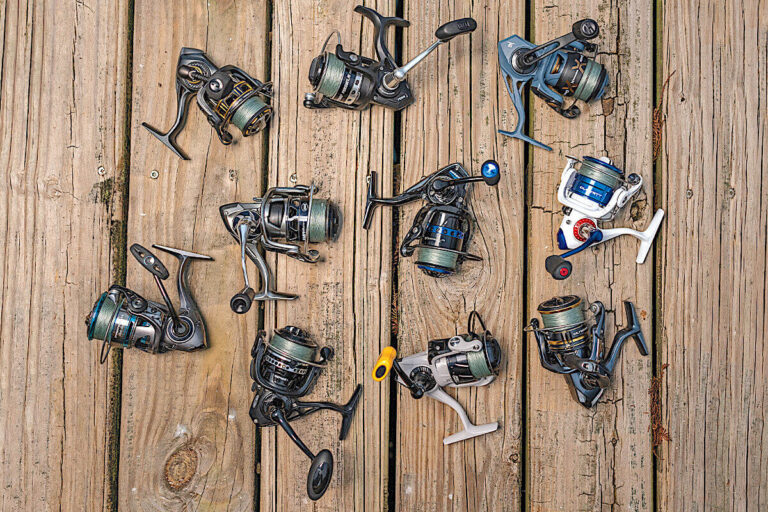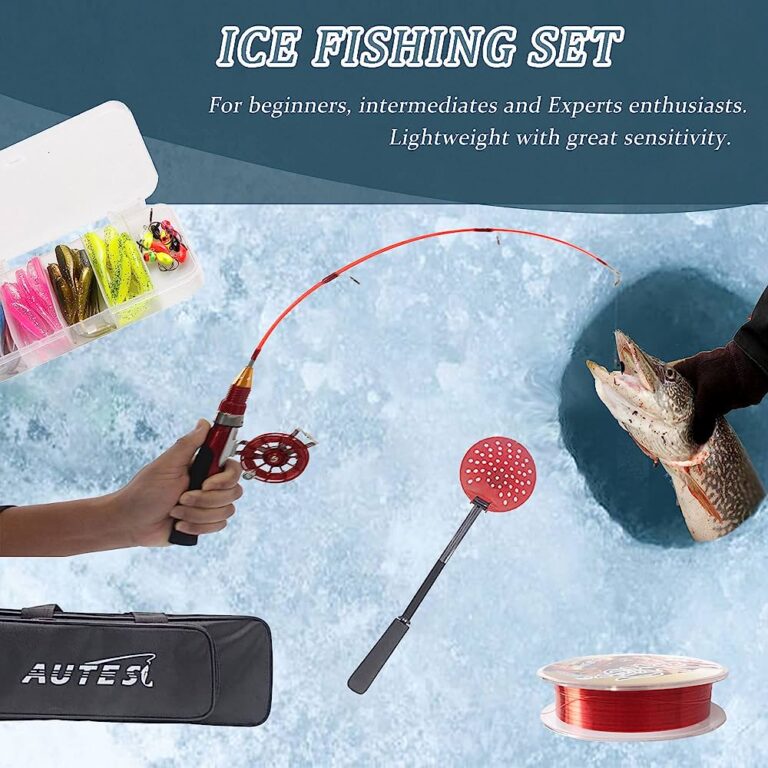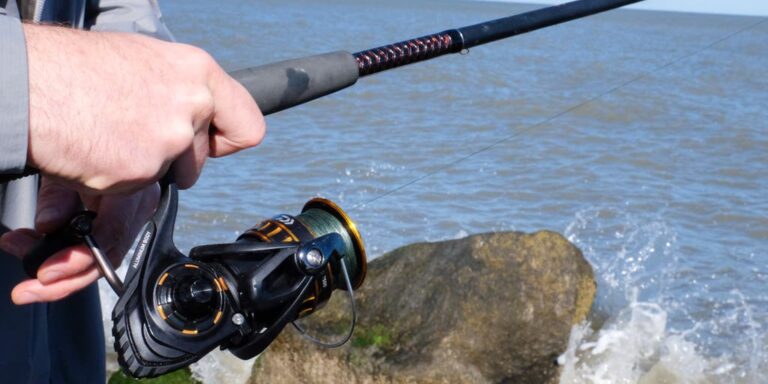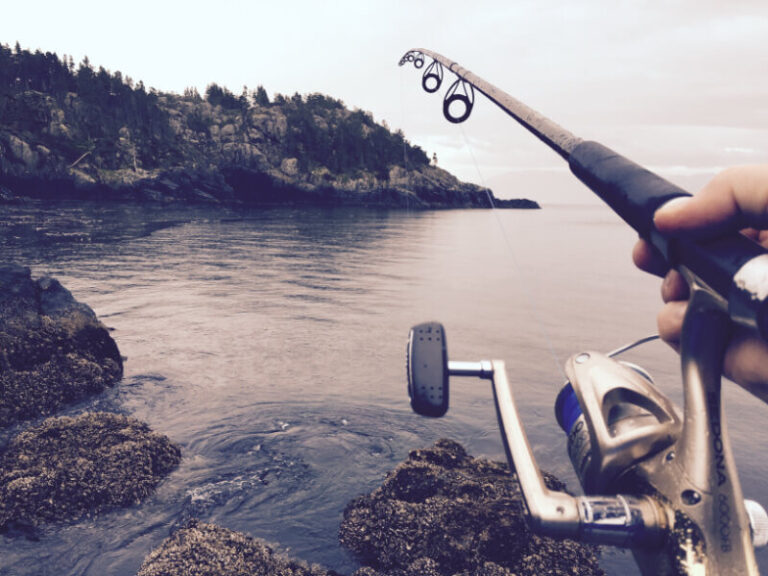Spinning gear is easier to use and best for beginners, while baitcasting gear offers more control and accuracy for experienced anglers. Spinning gear is a popular choice for anglers new to fishing due to its ease of use and forgiving nature.
Baitcasting gear, on the other hand, is preferred by experienced anglers who value accuracy and control in their fishing technique. Baitcasting reels allow for precise lure placement and control over the speed and depth of the retrieve. This type of gear requires more skill to operate effectively but offers a higher level of control once mastered.
Ultimately, the choice between spinning gear and baitcasting gear depends on the angler’s skill level, fishing style, and personal preferences.
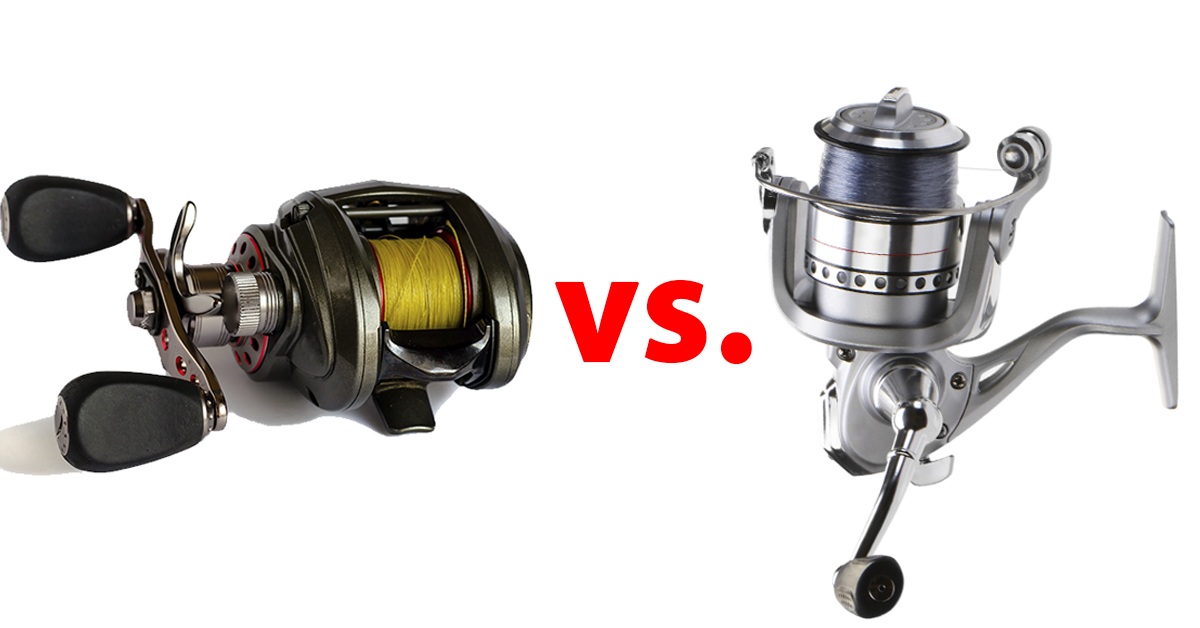
Credit: www.saltstrong.com
Overview Of Spinning Gear Vs Baitcasting Gear
If you’re an avid angler, you know that choosing the right fishing gear can make a significant difference in your fishing experience. Spinning gear and baitcasting gear are two popular options among anglers, each with its own unique features and advantages.
In this section, we will provide an overview of the key differences between spinning gear and baitcasting gear, emphasizing the importance of selecting the right gear for specific fishing techniques.
Key Differences Between Spinning Gear And Baitcasting Gear
When it comes to spinning gear versus baitcasting gear, here are the main points to consider:
- Mechanics: Spinning gear relies on a fixed spool reel, where the line is guided onto the spool by a fixed bail. Baitcasting gear, on the other hand, uses a revolving spool reel that requires the angler to control the line with their thumb.
- Casting: Spinning gear is known for its ease of use when it comes to casting. It allows for long, accurate casts with minimal effort, making it a great choice for beginners or anglers who value convenience. Baitcasting gear, although more challenging to master, offers greater casting accuracy and control, especially when dealing with heavier lures or in situations that demand precision casting.
- Line type: Spinning gear is compatible with lighter lines, such as monofilament or fluorocarbon, which are commonly used in finesse fishing techniques. Baitcasting gear is better suited for heavier lines, like braided lines, which are often employed when fishing for large, hard-fighting species or in situations that require increased strength and durability.
- Drag system: Spinning gear typically features a front-mounted drag system, which is easy to adjust and provides a smoother drag experience. Baitcasting gear commonly utilizes a star drag or magnetic brake system, offering anglers more control over line tension and the ability to quickly adjust when fighting a fish.
Importance Of Choosing The Right Gear For Specific Fishing Techniques
Selecting the appropriate gear for the fishing technique you plan to employ is crucial for a successful angling experience. Here’s why it matters:
- Efficiency: Using the right gear ensures optimal efficiency when executing specific fishing techniques. Spinning gear excels in finesse techniques, such as drop shotting or lightweight jigging. Baitcasting gear shines in power fishing techniques, such as flipping, pitching, or topwater fishing.
- Accuracy and control: Matching your gear to the fishing technique at hand allows for greater accuracy and control over your casts, presentation, and overall fishing performance. Whether it’s making pinpoint casts into tight cover or manipulating your lure with precision, the right gear can significantly enhance your angling skills.
- Comfort: Fishing with the appropriate gear for your chosen technique enhances your overall comfort on the water. It reduces unnecessary strain or fatigue, allowing you to fish for more extended periods without compromising your enjoyment.
- Success: Ultimately, selecting the right gear for specific fishing techniques increases your chances of success on the water. Every fishing technique has its requirements, and having the correct gear can make a substantial difference in hooking and landing fish consistently.
In the following sections, we will delve deeper into the specific characteristics and applications of spinning gear and baitcasting gear, providing you with valuable insights to help you determine which option best suits your fishing style and preferences.
Versatility And Ease Of Use
Spinning gear and baitcasting gear are two popular options for anglers when it comes to choosing their fishing equipment. While both have their own advantages and disadvantages, this section will focus on the versatility and ease of use of spinning gear.
Whether you are a beginner or an experienced angler, spinning gear can be a great choice for various fishing techniques.
Highlight The User-Friendly Nature Of Spinning Gear
- Spinning gear is known for its user-friendly nature. It has a simple design that makes it easy to handle, making it suitable for anglers of all skill levels.
- The spinning reel is situated underneath the fishing rod, allowing for a more natural and comfortable grip while casting and reeling in fish.
- The spinning reel’s open face design makes it easier to load the line and prevent tangles, especially for those who are just starting out in fishing.
- The bail system in spinning gear helps prevent backlash and allows for smooth and controlled line release during casting.
Discuss How Spinning Gear Is Suitable For Beginners And Experienced Anglers Alike
- Beginners can benefit from using spinning gear as it provides a forgiving and less complicated casting experience. Its open face design helps minimize the learning curve and reduce the chances of frustrating line tangles.
- Experienced anglers can appreciate spinning gear for its versatility and ease of use. It allows them to quickly switch between fishing techniques and adapt to different conditions without the need for reconfiguration.
- The lightweight and balanced nature of spinning gear make it comfortable to use for extended periods, reducing strain and fatigue on the angler.
- Spinning gear also provides more control when it comes to fighting and reeling in larger fish, thanks to its smooth drag system and efficient line retrieval.
Cover The Versatility Of Spinning Gear For Various Fishing Techniques
- Spinning gear can be used for a wide range of fishing techniques, including light to medium freshwater fishing, saltwater surf casting, and finesse techniques like drop-shotting and jigging.
- It offers the flexibility to use different types and weights of fishing line, allowing anglers to adapt their setup based on the target species and fishing conditions.
- The spinning reel’s ability to cast lightweight lures and baits with accuracy makes it ideal for finesse fishing, where precision is crucial.
- Spinning gear enables anglers to fish in different water depths, from shallow lakes and rivers to deep offshore areas, making it a versatile choice for various fishing environments.
Spinning gear offers anglers of all levels a user-friendly and versatile option for their fishing needs. Its ease of use, flexibility, and comfort make it a popular choice for beginners venturing into the fishing world and experienced anglers looking for a reliable and adaptable tool.
With spinning gear, you can confidently explore different fishing techniques and enjoy the thrill of reeling in your catch.
Smooth Casting And Handling
Discuss The Smoothness And Ease Of Casting With Spinning Gear
Spinning gear offers a smooth and effortless casting experience, making it a popular choice among anglers. Here are some key points to consider:
- Versatile casting: Spinning gear provides anglers with the ability to cast in various fishing scenarios, such as rivers, lakes, and even sea fishing. Its design ensures that casting is smooth and accurate, regardless of the fishing environment.
- Fixed spool mechanism: One significant advantage of spinning gear is its fixed spool mechanism. This allows the line to unwind freely from the spool without any resistance, resulting in a smoother cast. As a result, anglers can achieve longer and more controlled casting distances.
- Easy to handle: Spinning gear’s design offers excellent handling capabilities, particularly for beginners. It requires less skill and practice compared to baitcasting gear, as the line is released from the spool with a simple release button or flip of the bail. This ease of handling makes spinning gear a fantastic option for anglers of all skill levels.
- Reduced backlash: Unlike baitcasting gear, spinning gear is less prone to backlash, where the spool spins faster than the line being released, causing tangles and knots. The fixed spool mechanism allows for smoother and hassle-free casting, minimizing the chances of backlash, especially when using lighter lures.
- Ideal for long-distance casting: Spinning gear’s smooth casting ability makes it ideal for long-distance casting. Anglers can effortlessly launch their lures or bait further into the water, reaching those hard-to-reach spots where the fish may be lurking. This feature gives anglers an advantage when targeting larger species or fishing in spacious areas.
Spinning gear shines when it comes to smoothness and ease of casting. Its fixed spool mechanism, versatility, reduced backlash, and long-distance casting capabilities make it a go-to choice for anglers seeking a reliable and enjoyable casting experience. Whether you’re a beginner or an experienced angler, spinning gear offers convenience and precision that cannot be overlooked.
Better Control And Line Management
Spinning gear and baitcasting gear are two popular options when it comes to fishing reels. Both have their own advantages, but in terms of control and line management, spinning gear takes the lead. Here’s why:
Detail The Improved Control And Line Management Capabilities With Spinning Gear
- Spinning gear reels are designed to offer better control over the line. The spinning reel sits underneath the fishing rod, allowing for easy manipulation of the line during casting and retrieval.
- The open-faced design of spinning reels provides anglers with more direct control over the line’s movement, allowing for precise positioning of the bait or lure.
- With spinning gear, anglers can cast with lighter lures more effectively. The line can be released smoother and with less resistance, allowing for longer and more accurate casts.
- Spinning gear provides improved line management, especially when dealing with lighter lines and finesse techniques. It minimizes line twists and tangles, reducing the chances of a snag or a break-off.
- The reel’s drag system in spinning gear offers enhanced control over the fish during a battle. It allows you to adjust the resistance applied to the line, preventing sudden line breaks and giving you a better chance of landing the fish.
Discuss Features Like Anti-Reverse Mechanisms And Drag Systems
- Spinning gear incorporates essential features like an anti-reverse mechanism. This mechanism prevents the handle from turning backward, ensuring that the hook is set firmly when you reel in a fish. It adds an extra level of control, especially when dealing with aggressive or hard-fighting fish.
- The drag system of spinning gear is another standout feature. It allows you to control the amount of resistance applied to the line when a fish pulls it. This control is crucial as it helps prevent line breaks, keeps the tension steady, and avoids putting too much pressure on the fish. The drag system in spinning gear is usually located on the spool.
- Spinning reels often feature a front drag system, making it easily accessible and adjustable even while fighting a fish. This allows for quick modifications during the battle, maintaining constant control over the fish.
Highlight How Spinning Gear Allows For Easier Line Retrieval
- Spinning gear excels in line retrieval when compared to baitcasting gear. The design of the reel allows for rapid line retrieval due to the spinning spool mechanism.
- The larger diameter of the spinning reel’s spool enables faster line retrieval per revolution. This feature is particularly advantageous when targeting fast-moving fish or making multiple casts in quick succession.
- Spinning gear simplifies line retrieval, especially in situations where you need to quickly recast or when the fishing conditions require frequent lure or bait changes. Its ease of use allows for efficient fishing, maximizing your time on the water.
Spinning gear offers better control and line management capabilities compared to baitcasting gear. With features like anti-reverse mechanisms and drag systems, coupled with its ease of line retrieval, spinning gear provides anglers with enhanced precision and efficiency on the water.
Whether you’re a beginner or an experienced angler, spinning gear is a reliable choice when you need ultimate control over your fishing line.
Precision And Accuracy
Highlight The Precision And Accuracy Of Casting With Baitcasting Gear
Baitcasting gear offers unparalleled precision and accuracy when it comes to casting, making it a favorite choice among experienced anglers. With its unique design and features, baitcasting gear allows anglers to make precise adjustments for distance and accuracy, enabling them to target specific areas with ease.
Let’s delve into the reasons why baitcasting gear reigns supreme in terms of precision and accuracy.
Ability To Make Precise Adjustments For Distance And Accuracy
- Baitcasting gear provides anglers with the ability to finely tune their casts by adjusting the braking system, spool tension, and drag settings. These customizable features allow anglers to adapt to different fishing conditions and achieve the desired distance and accuracy.
- The centrifugal or magnetic braking system ensures that the spool slows down at the right moment, preventing backlash and ensuring a smooth and controlled cast.
- The spool tension knob allows anglers to fine-tune the tension on the spool, resulting in a more accurate and controlled cast.
- The drag system on baitcasting reels is typically more robust, providing anglers with the ability to set the drag precisely, allowing for better control when fighting and landing a fish.
Preferred Choice For Experienced Anglers Targeting Specific Areas
- The precision and accuracy offered by baitcasting gear make it the preferred choice for experienced anglers who want to target specific areas, such as structure, cover, or precise spots where fish are known to gather.
- Baitcasters excel in situations where precise lure placement is crucial, such as in heavy cover or when fishing for wary, hard-to-catch fish species.
- The ability to make accurate and long casts with baitcasting gear allows anglers to cover more water efficiently and reach areas that may be out of reach for other types of fishing gear.
- Baitcasting gear offers better control over the speed and direction of the cast, allowing anglers to present their lures in a more natural and enticing manner to fool even the most selective of fish.
In essence, baitcasting gear’s precision and accuracy make it a popular choice among experienced anglers who seek to refine their techniques and target specific fish-holding areas. Whether it’s the ability to make precise adjustments for distance and accuracy or the advantage of placing lures with pinpoint precision, baitcasting gear ensures that every cast counts.
Power And Line Capacity
Discuss The Increased Power And Line Capacity Of Baitcasting Gear
Baitcasting gear offers several advantages over spinning gear, particularly when it comes to power and line capacity. Let’s delve into why baitcasting gear is the preferred choice for anglers looking to tackle heavy-duty fishing and handle larger fish.
- With baitcasting gear, you’ll benefit from increased power due to its gear ratio. The gear ratio determines the number of times the spool rotates with each turn of the handle. Baitcasting reels typically have higher gear ratios, ranging from 5: 1 to 9:1, enabling quick retrieval of line and providing more control over bait presentation.
- The larger size and stronger construction of baitcasting reels result in enhanced line capacity. This means you can load more line onto the reel, giving you the ability to target fish in deeper waters or cast longer distances. The increased line capacity also comes in handy when battling powerful fish that may make long, blistering runs.
- Baitcasting reels often feature drag systems that can handle heavy loads efficiently. This is crucial when faced with hard-fighting fish, as the drag system ensures a smooth and controlled release of line, preventing it from breaking under pressure.
- The use of braided or heavier monofilament lines is more manageable with baitcasting gear. These lines are popular for their strength and durability. The sturdy construction of baitcasting reels allows for better casting and control of these types of lines, making them suitable for targeting larger species.
Address The Advantages Of Having A Larger, Stronger Reel
Opting for a larger, stronger reel, such as a baitcasting reel, comes with numerous benefits that enhance your fishing experience:
- The increased size of the reel translates to a larger line capacity. Baitcasting reels can accommodate significantly more line than spinning reels, enabling you to venture into deeper waters and pursue fish that dwell in remote locations.
- A larger reel allows you to spool thicker lines, such as braided lines or heavy monofilaments. These lines possess higher tensile strengths and are well-suited for battling larger fish species that put up a tough fight.
- Baitcasting reels often feature more robust constructions, incorporating durable materials like aluminum or high-quality alloys. This sturdiness ensures the reel can withstand the rigors of heavy-duty fishing and endure the strain exerted by hard-pulling fish without compromising performance.
- The larger size of the reel also contributes to increased drag capabilities. Baitcasting reels employ advanced drag systems that can generate substantial stopping power, preventing fish from breaking the line during intense battles.
- The ergonomic design of larger reels provides a comfortable grip and improved control, especially when wrestling with larger fish. This allows anglers to maneuver the reel smoothly and apply the necessary force while maintaining stability.
Explain How Baitcasting Gear Is Suitable For Heavy-Duty Fishing And Handling Larger Fish
Baitcasting gear is the preferred choice for anglers engaging in heavy-duty fishing and targeting larger fish due to the following reasons:
- The high gear ratios available in baitcasting reels provide increased power and torque, making it easier to handle larger fish species. The ability to retrieve line quickly aids in controlling powerful fish during their runs, resulting in more successful hooksets and smoother fights.
- Baitcasting gear offers superior accuracy and casting distance. The design of the reel, coupled with the placement of the spool, allows for precise bait placement, especially when dealing with heavier lures or rigs. This accuracy is essential when fishing in specific areas where larger fish are known to congregate.
- The robust construction of baitcasting reels ensures their ability to withstand heavy loads and prolonged battles. The durability of these reels is crucial when facing stronger fish, as it reduces the risk of gear failure and provides peace of mind to anglers.
- Baitcasting gear excels in providing the necessary control when battling larger fish. The enhanced drag system allows for fine adjustments, exerting just the right amount of pressure to tire out hard-fighting species without risking line breakage.
- The versatility of baitcasting gear allows anglers to adapt to various fishing techniques and conditions. Whether you’re trolling, jigging, or targeting freshwater or saltwater species, baitcasting gear provides the strength and performance needed to handle heavier tackle and land those trophy fish.
Baitcasting gear stands out in terms of power, line capacity, and suitability for heavy-duty fishing and larger fish. Its increased power, larger reel size, and sturdy construction offer advantages that spinning gear cannot match. Anglers seeking to take their fishing to the next level should consider embracing the strengths provided by baitcasting gear.
Control And Casting Techniques
Detail The Level Of Control And Casting Techniques Achievable With Baitcasting Gear
When it comes to control and casting techniques, baitcasting gear offers a higher level of precision and versatility compared to spinning gear. Here are some key points to consider:
- Precision control: Baitcasting gear allows anglers to have better control over their casts due to its design. With a baitcasting reel, you can adjust the spool speed and braking system to match your casting style and environmental conditions. This level of control enables you to cast with greater accuracy and target specific areas.
- Thumb pressure: One of the unique features of baitcasting gear is the use of thumb pressure to control the speed of the spool during casting. By applying pressure with your thumb, you can control the rate at which the line is released, preventing backlashes and ensuring smooth, controlled casts. This technique requires some practice to master, but once you get the hang of it, it becomes a valuable tool for precise casting.
- Pitching and flipping techniques: Baitcasting gear excels in techniques such as pitching and flipping, which are commonly used in bass fishing. These techniques involve making short, accurate casts to targeted areas such as around cover or under docks. Baitcasting reels provide the necessary control and power to execute these techniques effectively, allowing you to present your bait precisely where the fish are hiding.
In addition to these points, baitcasting gear also offers other advantages such as increased line capacity, stronger drag systems, and the ability to handle heavier lures. However, it’s important to note that baitcasting gear requires more skill and practice to use effectively compared to spinning gear.
As with any fishing equipment, it’s essential to choose the gear that suits your fishing style and preferences. With the right technique and practice, baitcasting gear can elevate your fishing game to the next level. So, grab your baitcasting setup and get ready to cast with precision and finesse!
Factors To Consider
Provide A Summary Of The Advantages Discussed For Both Spinning Gear And Baitcasting Gear
Spinning gear:
- Versatile: Spinning gear is suitable for beginners and experienced anglers alike. It offers easy operation and allows for longer casts.
- Lightweight and balanced: The design of spinning gear ensures a lightweight and balanced setup, reducing arm fatigue during long fishing sessions.
- Fewer backlashes: The spinning reel’s open-faced design and the absence of a level wind mechanism result in fewer backlashes and tangles.
- Superior line management: Spinning reels excel at managing light lines, making them ideal for finesse fishing techniques and situations where precision is required.
Baitcasting gear:
- Casting accuracy: Baitcasting gear provides excellent casting accuracy, especially when targeting specific structures or areas on the water.
- Power and control: Baitcasting reels offer more power and control, making them suitable for heavy and large fish species.
- Line capacity: Baitcasting reels have larger line capacities, enabling anglers to use heavier lines for tackling bigger fish or fishing in heavier cover.
- Drag system: Baitcasting reels usually have stronger drag systems, allowing anglers to fight and land more stubborn fish effectively.
Highlight The Importance Of Considering Personal Preference And Fishing Style When Selecting Gear
Personal preference:
- Comfort and confidence: Selecting gear that feels comfortable and instills confidence in the angler is crucial for an enjoyable fishing experience.
- Ergonomics: Considering factors such as grip design, handle length, and overall reel size can help anglers find gear that suits their physical abilities and preferences.
- Familiarity: Experienced anglers may prefer sticking to the gear they are accustomed to, as it allows them to maintain their fishing technique and maximize their potential.
Fishing style:
- Technique compatibility: The type of fishing technique one prefers, such as finesse fishing, topwater fishing, or heavy cover fishing, influences the choice of gear to optimize success.
- Casting distance and accuracy: Different gear options offer varying casting distances and accuracy levels, which should complement one’s fishing style and the targeted fishing spots.
- Lure weight and types: Certain gear excels at handling specific lure weights or types, so considering the type of lures one intends to use can help select the right gear for optimal performance.
Discuss The Need To Match The Gear To The Target Species And Fishing Conditions
Target species:
- Size and power: The size and power requirements of the target species should determine the gear’s strength and capability to handle the fish effectively.
- Drag strength: Certain fish species are known to have powerful runs, requiring a reel with a strong drag system to prevent line breakage and secure successful catches.
- Sensitivity: Gear should be chosen with consideration for the desired sensitivity level, allowing anglers to detect light bites or subtle movements from specific species.
Fishing conditions:
- Water type: Factors like saltwater or freshwater, as well as fishing inshore or offshore, necessitate gear that can withstand the corrosive effects of saltwater or handle different water environments.
- Weather conditions: Windy conditions or fishing in strong currents may require gear that provides better control and stability, ensuring effective angling even in challenging conditions.
- Line strength and visibility: The clarity of the water and the target species’ behavior influence the choice of gear, with considerations for using the appropriate line strength and visibility.
Remember, finding the right gear involves considering personal preferences, fishing style, target species, and fishing conditions. By taking all these factors into account, anglers can optimize their chances of success and enjoy a rewarding fishing experience.
Expert Tips And Recommendations
When it comes to choosing gear for your fishing adventures, getting insights from experts can be invaluable. Fishing experts have years of knowledge and experience in various fishing techniques, and they can provide valuable recommendations on whether to use spinning gear or baitcasting gear based on specific scenarios.
Here are some expert tips and recommendations to help you make an informed decision:
- Spinning gear:
- Spinning gear is highly recommended for beginners or anglers who prefer a user-friendly option. It offers ease of use and versatility, making it suitable for a wide range of fishing techniques.
- Spinning gear excels in scenarios where finesse and light line are required. It is ideal for casting lightweight lures, such as small jigs or soft plastics, with precision and accuracy.
- Fishing experts recommend using spinning gear for techniques like drop shotting, finesse techniques, and fishing in open water or areas with structure that requires accurate casts.
- With its easy-to-master mechanics, spinning gear allows anglers to focus more on the technique and presentation rather than struggling with gear control.
- It is also a great choice for fishing in windy conditions, as it offers better line management and minimizes the risk of backlash.
- Baitcasting gear:
- Baitcasting gear is favored by experienced anglers who require precision and control for specific fishing techniques. It offers excellent accuracy and power, making it suitable for heavy-duty fishing.
- Baitcasting gear excels in scenarios where casting larger lures or handling heavier lines is necessary. It provides superior casting distance and allows for efficient lure retrieval.
- Fishing experts recommend using baitcasting gear for techniques such as flipping and pitching, trolling, and fishing in heavy cover or thick vegetation where accuracy and power are crucial.
- With its adjustable braking system and spool control, baitcasting gear offers anglers the ability to cast accurately and control the lure’s movement throughout the retrieve.
- It also provides better leverage for fighting and landing larger fish, thanks to its rugged construction and strong drag system.
It’s worth noting that personal preference plays a significant role in gear selection, and each angler may have different needs and fishing styles. As you gain more experience, it’s essential to try both spinning gear and baitcasting gear to see which one suits you best.
Don’t be afraid to experiment and find your preferred option based on the fishing techniques you enjoy and the scenarios you encounter. The ultimate goal is to have gear that feels comfortable and empowers you to have an enjoyable and successful fishing experience.
So, explore both gear types, consult with experts, and discover the one that enhances your fishing adventures the most.
Conclusion
To summarize, understanding the difference between spinning gear and baitcasting gear is crucial for any angler looking to improve their fishing experience. Spinning gear offers versatility, ease of use, and is suitable for beginners or those looking for a more relaxed fishing style.
On the other hand, baitcasting gear provides precision and control, making it ideal for experienced anglers who desire accuracy in their casts and need to handle heavier lines and lures. Both gears have their advantages and disadvantages, but ultimately, it depends on personal preference and the fishing techniques one wishes to employ.
It is essential to consider factors such as target species, fishing conditions, and individual skills when choosing the right gear. So, whether you prefer the simplicity of spinning gear or the finesse of baitcasting gear, understanding their differences ensures a successful and enjoyable fishing adventure.
Happy fishing!

